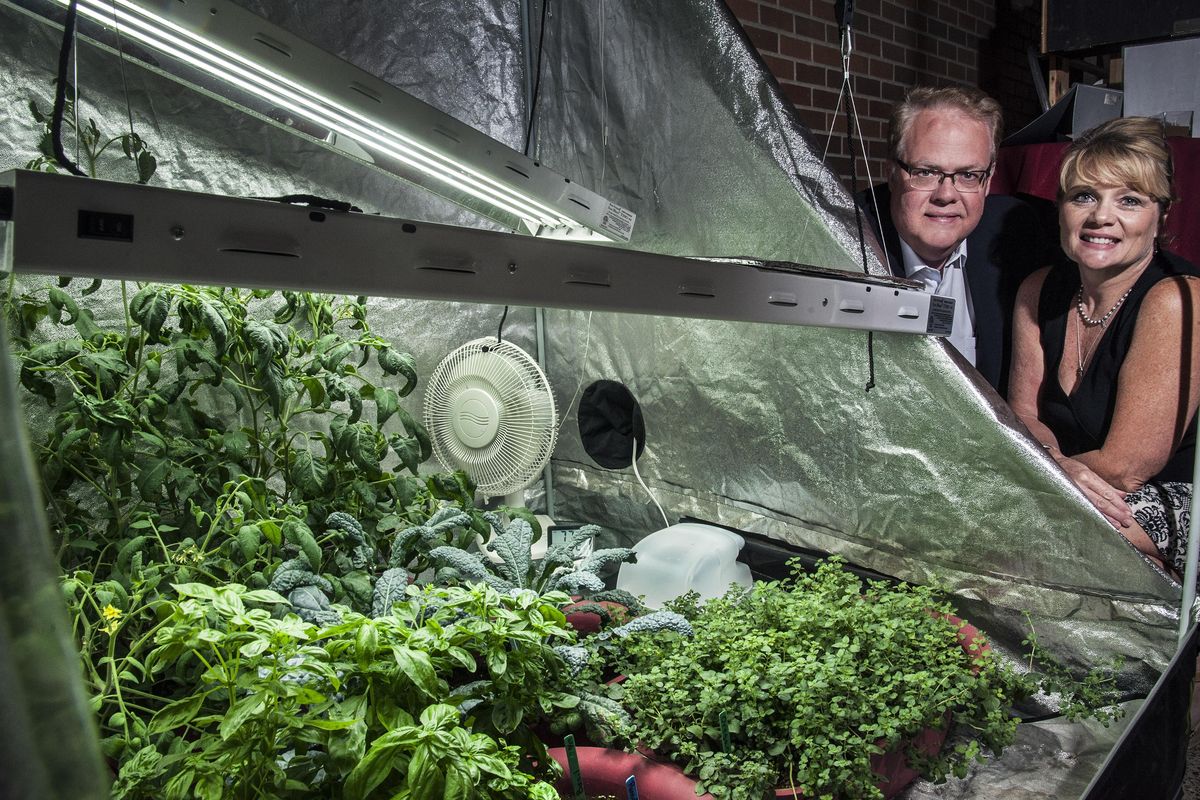Whitworth chefs inspired by ‘The Martian’ practice botany in Mars-like soil

Inside the cafeteria of Whitworth University is a black indoor-growing tent full of tomatoes, basil, kale, peas, leeks and edible viola flowers. Lights and fans are trained on the plants, and a bag that absorbs carbon dioxide hangs from above.
It’s a scene that would make botanist Mark Watney from “The Martian” proud: All of the plants are growing out of what NASA calls JSC Mars-1A – or, soil on Earth similar to Martian soil. It was mined from the Pu’u Nene cinder cone near one of Hawaii’s many long-dormant volcanoes on the Big Island.
Just as the fictional astronaut grew fields of potatoes from the nutrient-absent Martian soil, so too are a pair of chefs at Whitworth – though they aren’t growing potatoes just yet, or using human feces as fertilizer.
“We just use Maxsea plant food,” said Christine Logan-Travis, holding up the container as she checked on her plants recently.
Along with Whitworth’s Executive Chef Timothy Grayson, Logan-Travis has been growing these plants since April.
Grayson had the idea after reading a science publication about NASA’s interest in growing plants on Mars – interest that peaked after “The Martian” film was released late last year. The space agency has historically welcomed collaborative science projects from universities and everyday citizens who have helped discover things such as supernovas or identified gamma ray bursts. And for $37, anyone can order 2 pounds of soil, or in Grayson’s case, 10 pounds for $132.
“The more I thought about it, the more I thought it was a good idea to interface with the students here,” Grayson said. “And, make it an informational-type thing.”
In the past, scientists at NASA had funded research that looked into one of space exploration’s biggest predicaments: how to feed people on prolonged voyages. But large budget cuts meant dialing back on certain programs, including areas of advanced life support research, like the kind Ray Wheeler leads at the Kennedy Space Center in Florida.
“There’s not a lot happening right now,” Wheeler said. “It’s kind of a lull in funding.”
Like Watney, Wheeler is a botanist. He’s devoted his life to finding out the best ways to keep humans alive in space. He focused his postdoctoral work at the University of Wisconsin on potatoes, and he was instrumental in getting Veggie – a plant-growth system on the International Space Station – off the ground and into orbit.
Lately, he’s been looking into hydroponics – a method of growing plants without soil. While it would be difficult to use hydroponics in orbit, Wheeler says it would be much easier to remove the soil from the equation completely should humans eventually colonize Mars, as so many science fiction writers have fantasized about.
Since Mars has no plant life and hasn’t had water for billions of years, Martian soil is devoid of things that make plants grow, such as nutrients, minerals and organic matter. So, a whole lot of fertilizer is needed. And while Watney was able to get by with human feces in a fictionalized setting, scientists say the hassle may not be worth it.
“You would have to add nutrients into the soil because the soil is just crushed rock,” NASA rock expert Robert Mueller said. “You would have to add fertilizer, you would have to add water, you would have to put it in an environment where it would grow well.”
Still, Mueller said it’s fun to theorize about what kind of plants Martians would be harvesting, and the methods they would use.
The other major problem Martian farmers would run into is the need to pressurize a greenhouse, which means relatively little outside light due to lack of windows. Since everything in space travel has to be calculated ahead of time, this means more power devoted to lamps.
Plus, every kilogram launched into space costs about $10,000, and every kilogram sent to Mars costs upward of $10 million – leading NASA scientists to the more efficient hydroponic solution.
“You can give the plants the exact nutrients they need with less volume than you need with soil,” Mueller said.
Whitworth’s Grayson and Logan-Travis are undeterred, no matter what NASA plans to do when the time comes to send humans to Mars – a feat the space agency hopes to accomplish as early as 2030.
They knew from the get-go they weren’t going to turn the world of botany on Mars upside down. If anything, they thought it would be fun to make a “Martian salad” to be given away to students who win a contest in the fall. (They’re thinking caprese, since they already have the basil and tomatoes.)
But until then: potatoes, just like Watney.
“That would be good, huh? Because of the movie,” Grayson said in his Southern drawl. “I mentioned that the other day. You know, we should have done that.”